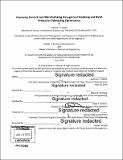| dc.contributor.advisor | Brian W. Anthony and Sean P. Willems. | en_US |
| dc.contributor.author | Freiheit, Andrew J. | en_US |
| dc.contributor.other | Sloan School of Management. | en_US |
| dc.contributor.other | Massachusetts Institute of Technology. Department of Mechanical Engineering. | en_US |
| dc.contributor.other | Leaders for Global Operations Program. | en_US |
| dc.date.accessioned | 2019-10-11T22:25:03Z | |
| dc.date.available | 2019-10-11T22:25:03Z | |
| dc.date.copyright | 2019 | en_US |
| dc.date.issued | 2019 | en_US |
| dc.date.issued | 2019 | en_US |
| dc.identifier.uri | https://hdl.handle.net/1721.1/122592 | |
| dc.description | Thesis: M.B.A., Massachusetts Institute of Technology, Sloan School of Management, 2019, In conjunction with the Leaders for Global Operations Program at MIT | en_US |
| dc.description | Thesis: S.M., Massachusetts Institute of Technology, Department of Mechanical Engineering, 2019, In conjunction with the Leaders for Global Operations Program at MIT | en_US |
| dc.description | Cataloged from PDF version of thesis. | en_US |
| dc.description | Includes bibliographical references (page 55). | en_US |
| dc.description.abstract | J&J Vision Care (JJVC) uses production scheduling methods that are not fully optimized, causing over-production of certain SKUs, and reducing capacity for other SKUs on backorder. This makes planning a weekly run-schedule for each line difficult. It is also difficult to understand where to invest capital to create an optimally flexible fleet of production lines. JJVC is currently capacity-constrained, so optimizing the production to increase output will directly translate to additional revenue. The three main areas that the leadership team wants to explore in this project are: 1. What is our current fleet flexibility? 2. How much capacity can be freed up if our fleet was more flexible? 3. Can we create a cost modeling tool that will provide more granularity in brand and sales channel profitability? First, the brands and SKUs on each line that are "validated" to run (by FDA, etc.) must be quantified. | en_US |
| dc.description.abstract | Not all validated SKUs on a line are "runnable" though: Process issues often arise in the plant that prevent some of these validated SKUs from being produced (e.g. mechanical tolerances, chemistry, etc.). Therefore, the gap between validated and runnable SKUs will be an opportunity to explore. One constraint originally studied was the "runnable" vs "validated" prescriptions at the Jacksonville site; The percentage of runnable vs validated SKUs is only 73%, meaning that 27% of the prescriptions that J&J invested time and money to validate cannot be produced on certain lines due to manufacturing issues. The impact of this constraint and others can be quantified to identify improvement opportunities. Second, potential additional capacity can be calculated by running a sensitivity analysis with the planning tool (i.e. the optimization model) to analyze how outputs (e.g. throughput, changeover times, etc.) are affected by changing certain inputs: Mold, core, and pack change times, production rate, minimum lot sizes, service level, etc. It is also possible to change the objective function to place more weight on certain user-defined parameters. | en_US |
| dc.description.abstract | The impact of these changes were observed by collecting the master planning data for a defined time-period and running optimization scenarios. Various time horizons were used to gain an accurate understanding of the impact. Third, to understand how the initiatives described above improve both revenue and costs, a clear understanding of the profitability of each lens must be considered before JJVC management makes high-level strategic decisions. To make this possible, a Total Delivered Cost (TDC) model was developed and published a for the Contact Lens supply chain. | en_US |
| dc.description.statementofresponsibility | by Andrew J. Freiheit. | en_US |
| dc.format.extent | 60 pages | en_US |
| dc.language.iso | eng | en_US |
| dc.publisher | Massachusetts Institute of Technology | en_US |
| dc.rights | MIT theses are protected by copyright. They may be viewed, downloaded, or printed from this source but further reproduction or distribution in any format is prohibited without written permission. | en_US |
| dc.rights.uri | http://dspace.mit.edu/handle/1721.1/7582 | en_US |
| dc.subject | Sloan School of Management. | en_US |
| dc.subject | Mechanical Engineering. | en_US |
| dc.subject | Leaders for Global Operations Program. | en_US |
| dc.title | improving contact lens manufacturing through cost modeling and batch production scheduling optimization | en_US |
| dc.type | Thesis | en_US |
| dc.description.degree | M.B.A. | en_US |
| dc.description.degree | S.M. | en_US |
| dc.contributor.department | Sloan School of Management | en_US |
| dc.contributor.department | Massachusetts Institute of Technology. Department of Mechanical Engineering | en_US |
| dc.contributor.department | Leaders for Global Operations Program | en_US |
| dc.identifier.oclc | 1119537588 | en_US |
| dc.description.collection | M.B.A. Massachusetts Institute of Technology, Sloan School of Management | en_US |
| dc.description.collection | S.M. Massachusetts Institute of Technology, Department of Mechanical Engineering | en_US |
| dspace.imported | 2019-10-11T22:25:02Z | en_US |
| mit.thesis.degree | Master | en_US |
| mit.thesis.department | Sloan | en_US |
| mit.thesis.department | MechE | en_US |
